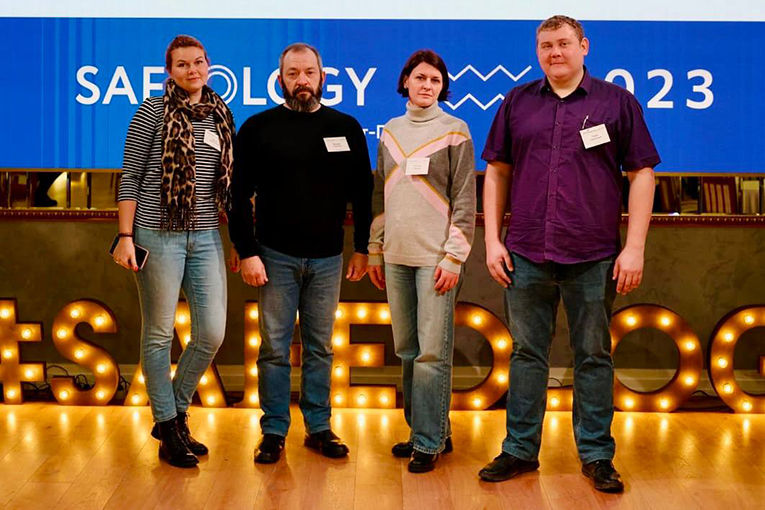Occupational health and safety: management, engagement, partnership
Press-centre / News,
A significant part of accidents at enterprises is associated with the human factor: employees sometimes underestimate hazard risks. Various standards, rules and instructions are being introduced to address this problem. But a formal approach is barely adequate – everyone needs to be aware of the importance of safety and help improve it.

In late 2022, EkoNiva launched the Safety Culture and Occupational Health and Safety Management System Development project and adopted new methods in this area at its enterprises. Outside experts from Safeology Group also contribute to this work. Tatyana Lyapina, Deputy Director General for Human Resources at EkoNiva Group, and Lana Altynbekova, Manager of Safeology Group, elaborated on the current challenges and optimal solutions to them.
In any industry, especially in production, there exists a priori safety culture based on legal requirements and internal regulations. So what is relevant about EkoNiva’s project and what is it aimed at?
Tatyana: ‘Although everyone understands the importance of laws and internal requirements, people sometimes tend to treat them as a mere formality. Certain stereotypes and patterns of thinking come out. For example, a long-time employee may think: “I have been doing my job for so many years without any problems occurring, so everything will be fine’. One of the key objectives of our project is to get rid of such way of thinking, cultivate safety awareness in every employee and responsibility for their own and their colleagues' safety, thus motivating everyone to participate in perfecting the occupational health and safety system. At the end of 2023, our corresponding department took part in a specialised conference in St. Petersburg, where they met experts from Safeology. The latter are now taking active part in implementing new methods, keeping the specifics of the industry and the scale of the Group in mind.’
Lana: ‘I would like to add that although a certain safety culture does exist at any enterprise, it is not always managed properly. As far as we can judge, there are few companies that set themselves such a goal in the farming sector. EkoNiva has ambitious plans as to this issue, which cannot but inspire deep respect. In agriculture, there are risks at the levels of human-human, human-technology, human-environment and human-animal interactions, which requires not only formal control, but also constant optimisation and improvement of safety culture.’
What tools can be used to achieve this and what measures are already being implemented at EkoNiva?
Tatyana: ‘It is essential to take a comprehensive approach, which implies introducing safer production technologies and various digital solutions, carrying out systematisation and risk analysis, studying employees' work habits and behaviour, training managers and line staff to get them engaged in this aspect. They need to grasp the idea that first and foremost, safety culture is central to their own life and health. Of course, all of the above-mentioned cannot be done quickly and immediately and requires continuous hard work, especially in such a large company, where each area of production and each subdivision has its ins and outs. But it is worth the efforts – for example, the digitalisation of processes gives us a clearer understanding of the current challenges and frees up some time for our occupational health and safety officers to visit production sites, communicate with managers and other employees and promote safety culture at the local level.’
What exactly is already yielding results?
Tatyana: ‘In early 2023, in Voronezh oblast, we started a pilot project to identify and warn of threats and hazards. This year, plans are afoot to scale it up in other regions where we operate. With the programme called Stop Risk, employees can signal any risks at their sites, after which automated reports are generated for the working group to discuss and eliminate or prevent problems. Such feedback is most welcome as it makes people become engaged, think more about safety, want to learn how to improve safety culture together. In addition, the Three-Stage Monitoring programme is to be launched soon: at the first stage, the manager of a production area keeps track of the safety of conditions and work performance. At the second stage, the head of a subdivision controls on a weekly basis the steps taken following inspections that have already been carried out. The third stage includes a comprehensive examination of the occupational health and safety system – the commission checks the actions performed in accordance with previous instructions. All the information is entered in a summary report.’
Lana: ‘Basically, it is proactive work directed towards the future, not just dealing with occurring incidents. And the most important aspect of this approach is interaction with people which would lead to a shift in their thinking. There are thus increased requirements to occupational health and safety staff serving as agents of change. The emphasis is on fostering communication, negotiation and persuasion skills of both managers and line employees. Safeology experts are involved in training occupational health and safety specialists to enhance their safety knowledge, bringing it to the level of the best companies in the country. There is still much to be done, but the process is underway.’
Tatyana: ‘…Apart from making jobs safer, these activities have a number of other positive effects. Joint participation in settling such crucial issues and experience exchange further pull the team of our safety department together, which results in more favourable working conditions and warm atmosphere. Many of the projects implemented contribute to boosting staff engagement, receiving feedback from employees and developing intercommunication. In other words, they go beyond the scope of occupational health and safety.’